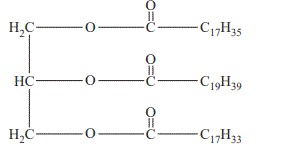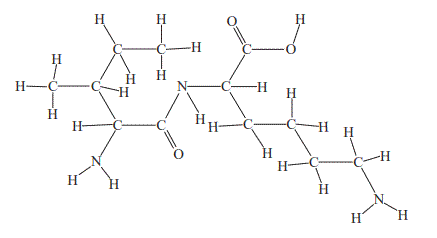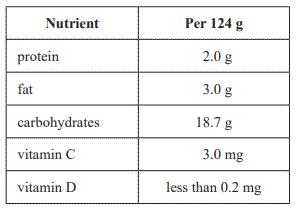1. People who are lactose intolerant have a deficiency of the lactase enzyme. Which one of the following statements about people who are lactose intolerant is correct?
A. Some of their consumed lactose remains undigested.
B. They metabolise lactose in a non-aqueous environment.
C. They are unable to digest the proteins found in dairy foods.
D. Their glycaemic index rises due to galactose passing into the blood.
Solution

2. Which of the following correctly identifies the bonds that break in a protein when it undergoes denaturation and when it undergoes hydrolysis?

The composition of fatty acids in an egg yolk was determined by reacting the fatty acids with methanol to produce methyl esters and then analysing the methyl esters using chromatography. Explain, using the principles of chromatography, how each fatty acid in the egg yolk sample can be identified and the percentage determined
Solution

3. A triglyceride is shown below.

Which one of the following statements about the triglyceride is correct?
A. The fatty acids from the triglyceride will not undergo oxidative rancidity.
B. The triglyceride will hydrolyse to carbon dioxide and water.
C. The triglyceride has three carbon–carbon double bonds.
D. The triglyceride is insoluble in water.
Solution

4.a. All nine essential amino acids are found in quinoa. State what is meant by an essential amino acid.
Solution
b. Consider the peptide below.

i. Circle the peptide bond in the dipeptide above.
ii. Name the amino acid with the non-polar Z group, which is involved in the formation of the dipeptide.
Solution

c. When papaya fruit is eaten with protein in a meal, it can aid the digestion of that protein. Explain why papaya can aid protein digestion.
Solution
d. Quinoa fat contains oleic acid and linoleic acid.
i. What type of omega fatty acid is linoleic acid?
Solution
ii. Which of the two fatty acids – oleic acid or linoleic acid – would be expected to have a lower melting point? Justify your answer.
Solution

e. Amylose and cellulose are two polysaccharides. Identify two similarities and one difference between the structures of amylose and cellulose.
Similarity 1
Similarity 2
Difference
Solution

5. The nutritional information for one medium serving (124 g) of sweet potato is provided in the table below.

a. Calculate the energy contained in one medium serving of sweet potato. 1 mark
b. Explain, with reference to the chemistry, how boiling sweet potato in water may affect its level of vitamin D. 3 marks
Solution

c. The loss of vitamin C, C6H8O6 , in sweet potato after heating can be determined in a titration by reacting vitamin C with iodine, I2 , solution. The balanced titration equation is shown below.
C6H8O6(aq) + I2(aq) → 2HI(aq) + C6H8O6(aq).
A sample of sweet potato was blended with water and filtered. The filtrate was titrated against 0.0500 M of I2(aq). The average of three concordant titres was 21.81 mL. Calculate the mass of vitamin C in the sweet potato sample. .
d.Some coenzymes are derived from vitamins. Explain the role of coenzymes in metabolic reactions.
Solution
